Interview: Artist Alexa Meade Creates Living Paintings
Alexa Meade paints directly onto her models, creating mind-blowing “living paintings” that exist both in the moment and on film for all time. Not surprisingly, she’s getting noticed, with showings all over the world including the Saatchi Gallery in London and Irvine Contemporary, where she’s represented in Washington, DC. Combined with a stint in politics working for the Obama campaign, at first glance, she herself seems a bit of an enigma. She was kind enough to grant us a glimpse into her process and a chance to understand her work and motivation.
stated: How would you describe your art?
ALEXA MEADE: Instead of painting a portrait on canvas, I will paint my portrait directly on top of the subject being referenced. I cover the skin and clothes of my models in a mask of nontoxic acrylic paint that mimics the colors and contours of the underlying surfaces, and then photograph them. This painting technique I innovated optically compresses 3D space into a 2D plane.
stated: It’s a truly fascinating style. I find I keep going back and discovering something new each time I look at your work. How did you develop it?
ALEXA MEADE: This project grew out of the simple concept I started exploring in the summer of 2008 of filling in shadows with black paint as they are cast under and on top of objects. After nine months of myriad experiments, I had that “ah-ha!” moment while painting my friend Bernie in May 2009. In the blink of an eye, everything I had been working on converged and the puzzle pieces fell perfectly into place. After spending several months honing my technique, I officially unveiled the project in October 2009.
stated: Wow, you’ve amassed quite a body of work in a fairly short time. It strikes me that it’s viewed first in-person with a live model as part of the experience, and then captured in photographs for posterity. In essence, you’re creating two separate works with each piece—the live experience and the photograph of the work, would you agree?
ALEXA MEADE: I paint directly on people because I am interested in exploring the tensions between being and permanence. I like the idea of creating something that will be destroyed immediately upon completion. Once the performance is resolved, the model rips off the acrylic mask and all that endures of my ephemeral painting is a photographic print documenting the time-based event.
I exhibit both the portrait/performance installations and the photography, but I do not sell installations or anything with a painted surface. The only thing that one can own is a photographic index of my representational painting.
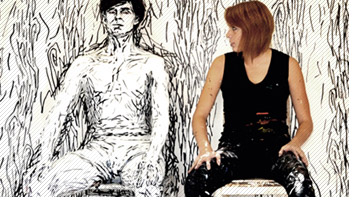 |
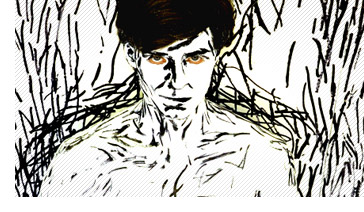 |
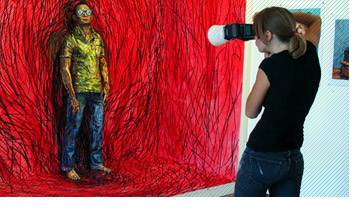 |
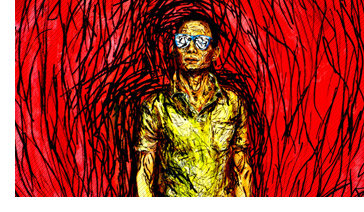 |
[ Subscribe to the Stated Magazine Newsletter and follow us on Facebook and Twitter! ]
stated: What generally comes first—your vision for the piece or the model? In other words, does the model determine the piece or the other way around?
ALEXA MEADE: While I may have a clear vision for how I want the work to go before I start the portrait, the process of getting to know my models better during the painting session tends to change all that. It’s very intimate having my face several inches from my models’ faces nonstop for several hours in a row. Conversations wander over all kinds of territory and I feel like I get a really great sense of the models, even when I’m painting on strangers that I might have only just met. I’m interacting with them the whole time while I’m making decisions about how to represent them. I’ll frequently throw out my sketches mid-way through and decide that I want to represent them totally differently than how I’d set out to. I’ll change my color palette and the direction of the painting to match my new viewpoint of the subject. I will never erase or start all over from the beginning. I prefer to build on the history of my previous brushstrokes to complement the additional layers of the understanding I have for the person sitting before me.
stated: Does knowing the model beforehand change that interaction?
ALEXA MEADE: I really enjoy painting total strangers because there are so many things to discover about them. Sometimes I’m the most surprised when painting close friends and family who I’d thought I already knew very well but got to learn so much more about through the process. I never work with professional models.
stated: Clearly that choice has worked for you. Are there any specific artists you feel have influenced your work—and do you find that individual pieces echo those influences?
ALEXA MEADE: I come from a background in sculpture, so I find myself really inspired by artists who work with our understandings of space. They include: Robert Irwin, James Turrell, and Olafur Eliasson. Lucian Freud and Jenny Saville influenced the painting styles for my earlier pieces. More recently, I have taken an interest in Elizabeth Peyton and Alice Neel. I also see my work in dialogue with Boo Ritson, Cindy Sherman, and Gillian Wearing.
stated: That’s quite an eclectic bunch, but I can absolutely see the connection. I understand you graduated from Vassar College with honors in Political Science—not art. On the surface, that seems like quite a disconnect. Do you feel the two are related?
ALEXA MEADE: In high school and college, I spent my summers interning in press shops on Capitol Hill. A major concept I have applied from my experience in political communications to my art is that what one experiences cannot always be interpreted at face value; seeing is not necessarily believing. My projects spin reality. By wrapping my subject in a mask of paint, I skew the way that the core of the subject is perceived.
stated: I know you’ve been applying to grad schools—will you be studying art, political science, or something else entirely?
ALEXA MEADE: I had always created art, but I was so used to hearing that it was a “hobby, not a career” that I hadn’t considered being an artist to be a viable profession. I studied political science at Vassar College and spent the spring semester of my junior year studying European politics in Copenhagen. While I was in Scandinavia, I realized that my heart was in art, not politics. Despite my doubts about a future in politics, I moved out to Colorado in the summer of 2008 to take a press job I had been offered on the Obama campaign. While the campaign was exciting, it made it clear to me that I wouldn’t be content with myself if I didn’t devote all of my attention to making art.
I plan on having a long-term art career and do not have any plans to go back into politics.
stated: While that’s surely a loss for politics, I’m glad to hear it will be the art world’s gain. What are you working on now?
I had limited edition prints exhibited in a group show titled “Saturnalia” at Irvine Contemporary in Washington, DC through March 4. In April, I will be a presenter at the EG Conference in Monterey.
stated: That’s quite a full plate. Thanks so much for joining us and all the best to you.
—-
Visit Alexa at:
www.alexameade.com
facebook.com/alexameade
twitter.com/alexameadeart
[ Subscribe to the Stated Magazine Newsletter and follow us on Facebook and Twitter! ]










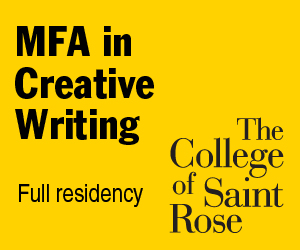
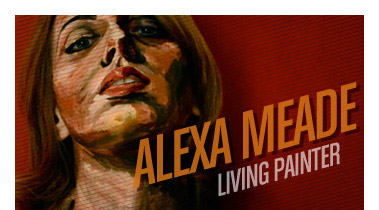
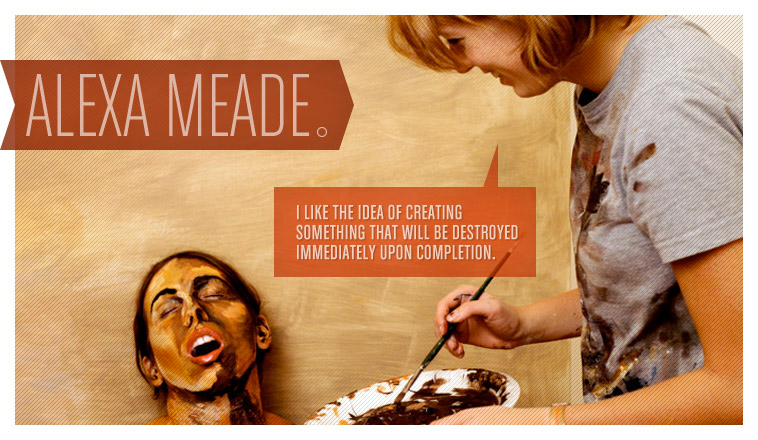
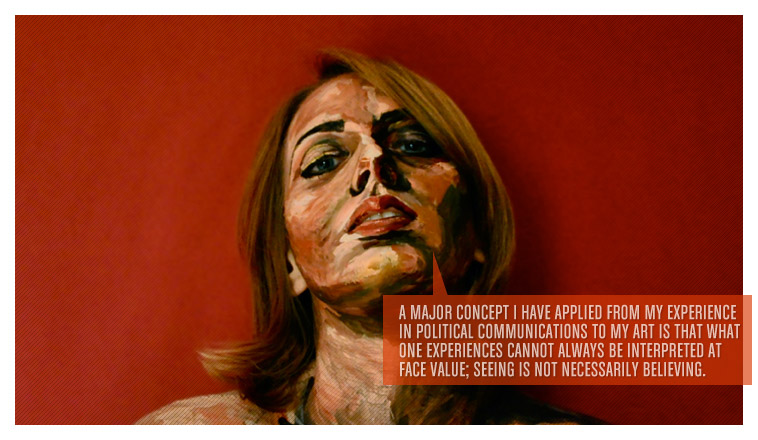
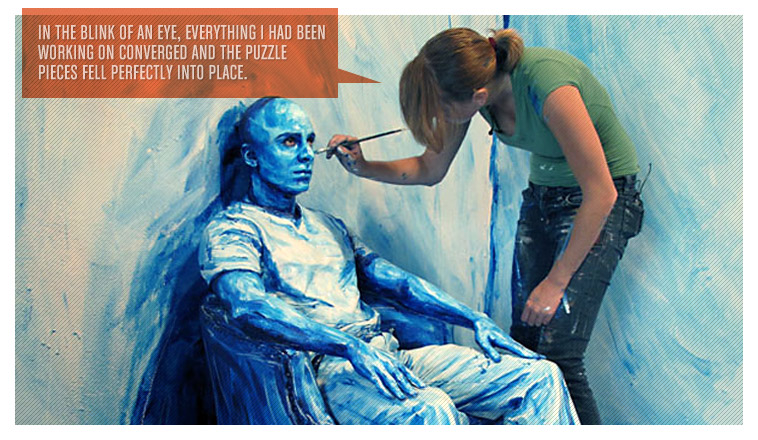
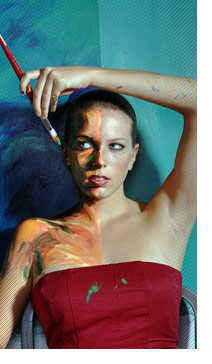
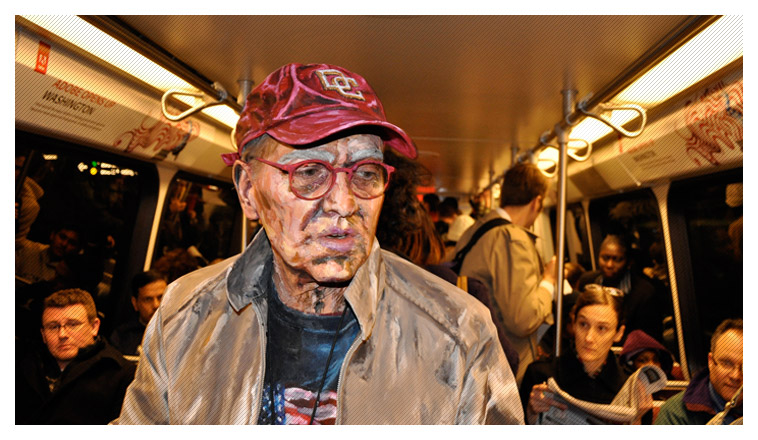
 Ryan Swearingen
Ryan Swearingen
Reader Comments